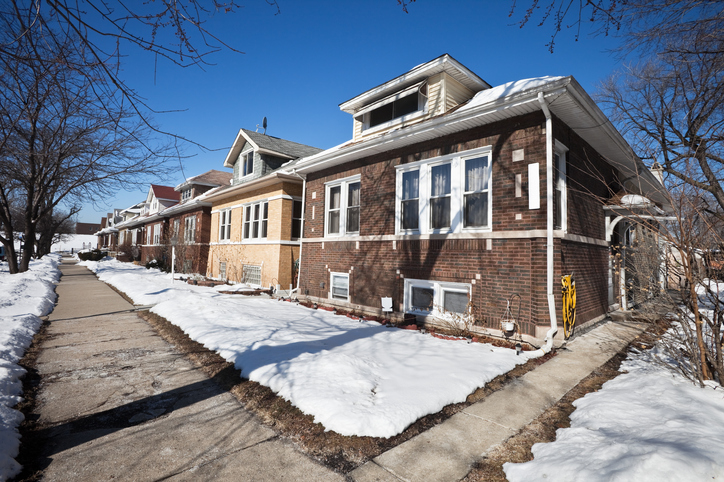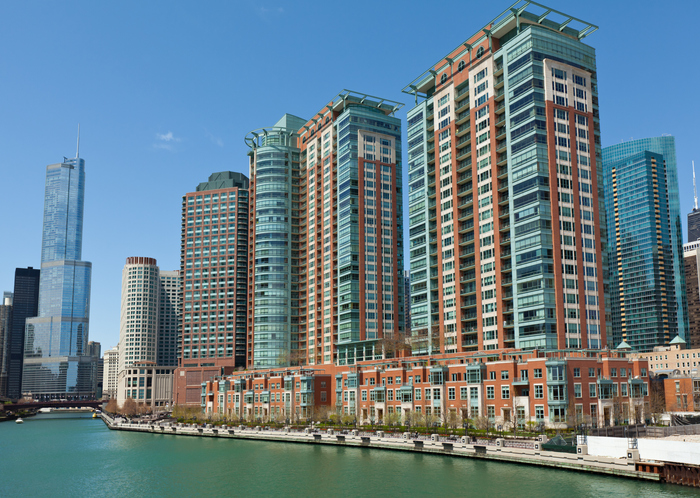Relocating to a new area can breathe an unrivaled sense of excitement into your life. That’s especially true when you’re moving to Chicago.
Becoming a resident Chicago means exposure to new people, places and adventures. Yet, a new city also means navigating an unfamiliar real estate market. If you are serious about moving to the Windy City, it is time to get your financial house in order and make a realistic assessment of how much moving to Chicago will cost you.
Here’s a guide to help you pilot your epic relocation adventure. From moving costs to the cost of living in Chi-Town to practical relocation tips, we’ve got you covered.
Costs to consider when moving to Chicago
As you may know, moving to a new city in any part of the world is going to cost you something. However, the relocation game plan and ultimate destination largely impact your final bill.
Executing a foolproof relocation strategy means being aware of all the potential costs of moving to Chicago. It helps to think of your move in baby steps, starting with the packing process. For instance, what will it take to pack your entire home into moving crates or boxes?
Here’s a common rabbit trail—if you’re downsizing from a 2,400 sq. ft. home to an apartment or even a famed Chicago bungalow, you may be living in half the square footage (or less). For you, moving may mean storing or even selling your items, which could possibly incur fees.
Moreover, consider this list of possible moving costs:
- Moving expenses (boxes, tape, packing, etc.)
- Full-service moving
- Moving truck rental (and gasoline)
- Toll charge for the moving truck
- Hiring movers
- Temporary storage
- Eating out during the moving process
- Time off of work
- Moving insurance
- Pet boarding
How to estimate your moving costs
One of the greatest things since sliced bread, cost calculators can help you maintain your moving budget. Also, don’t be shy about getting estimates for things such as truck rentals, gasoline costs, and even full-service moving quotes.
And that’s just for starters.
To get your household from point A to point B, follow a similar planning strategy as mentioned earlier. Think about little details such as where you will eat out during the moving process. Or, how many nights you’ll need to stay in a hotel.
Furthermore, become familiar with Chicago neighborhoods, considering issues like street width. Which, in Chicago, may force movers to park the truck on a wider street and shuttle your belongings to your new home
Remember to double check on aspects such as when your new home will be available, the local sales tax (10.25% in Chicago), or how soon you’ll need to get a Chicago city vehicle sticker.
How to cut your relocation costs
In a society of discount-seekers, you’re likely on the hunt for a way to cut your costs of moving to Chicago. And, rightly so!
When it comes to moving, DIY is often the least expensive route. However, if you’re moving cross-country or even over 100 miles, DIY can be a physical and mentally demanding ordeal. Plus, you may still be processing a few things like the cost of living or even what it will be like living in Chicago.
Nevertheless, here are a few cost-cutting tips:
- Get estimates from movers (and hire them) a month in advance.
- Don’t move during peak season (May-Sept) or on holidays, if possible.
- Make friends ahead of time to help you unload.
- Declutter before packing so you don’t move junk.
- Gather free boxes from stores instead of buying new ones.
- Use towels, blankets, or clothes in place of bubble wrap.
- Leave items in dressers or drawers to avoid more boxes.
- Drive undistracted into the city (Chicago drivers are aggressive).
- Plan for the tolls (or remember to pay them via Illinois Tollway.
Cost of living in Chicago
So you can afford to move to Chicago, but can you afford to live in Chicago?
Unlike much of Small-Town America, living in a city like Chicago can quickly get expensive. And that’s aside from all the signature deep-dish pizza for which you will undoubtedly splurge.
Take the cost of annual car ownership in Chicago for example, which is slightly above $7,000. Mostly, this is due to the city’s congestion, parking fees, registration, and the high cost of auto insurance (often double the rest of the state).
Though Chicago sprawls over 230 square miles and features many types of homes, home ownership is below the national average. Basically, renting in Chicago usually makes more sense than buying. With that said, the average rent for a one-bedroom apartment (765 sq. ft.) in Chicago runs at around $1,499. Opting for a mortgage, expect a 1,000 sq.ft. one-bedroom home to go for around $201,500.
Contending with booming cities like New York or Boston, the average Chicago salary is $62,869 and the cost of living in Chicago is 23% above the national average. With Illinois ranking as the eighth most expensive state for child care cost, Chicago is still slightly above the national average in that department as well.
Often overlooked when moving to Chicago, utility bills come whether you rent or buy. In Chicago, an average utility bill—heat, electricity, gas, and water—rounds to a decent $125.
How to find affordable housing in Chicago
Whether you rent an apartment in the South Loop or opt for one of the historical single-family homes, there’s a neighborhood for everyone. But Chicago residents face a challenging market.
Categorizing available housing by property type, a public housing agency can help you find the kind of rental house desired. Also using a broker can assist in matching you with the right landlord.
As in many other large cities, Chicago landlords usually require your annual income to be 40-50 times your monthly rent. Some may stonewall you while others will be more lenient.
It helps to know how much rent you can afford. An easy formula is to simply take your annual salary and divide it by 40. So, if you’re making $100,000 per year then you can afford a $2,500 monthly rent payment.
If a great deal is what you want, here are 10 of the most affordable neighborhoods in Chicago:
- Rogers Park
- West Rogers Park
- Albany Park
- Edison Park
- The Robert Taylor Homes
- Edgewater Glen
- Edgewater Beach
- Hyde Park
- East Hyde Park
- Lakewood – Balmoral
Moving to the city often means downsizing. But, no one says you have to ditch your beloved furniture. Opt for temporary storage until you know your next step in life.
Relocation tips for Chicago
Depending on where you’re coming from, moving to Chicago may seem like moving to a different world. Like many other new cities, getting acclimated to the weather, culture, neighborhoods, or even grocery stores can be tricky.
Understand Chicago’s diversity
Many people assume that Chicago is nicknamed “The Windy City” because it’s forever-gusty. While there is often a chill wind blowing in from Lake Michigan, the name is said to represent hot air spewing from politicians.
Nevertheless, Chicago experiences four distinct seasons—cool springs, humid summers, crisp falls, and bitter winters. Yet, with average winter temperature in the mid-twenties, Chicago is often more a walk in the snow than a walk in the park (though it does have over 550 parks).
But Chicagoans are known for their resilience—think about the great fire of 1871—overcoming the moody weather by not owning a car. Actually, navigating the gorgeous city on foot has proven to be a common quest.
Being a Chicagoan not only means walking a lot but also loving your sports teams as much as the well-known food. For example, a must-visit hotspot for any foodie is undeniably the West Loop. It’s a treasure trove of deliciousness.
Even with a contending cuisine, the easygoing vibe in Chicago is unlike the constant anxiety-inducing rush of New York or Boston. However, it can be a bit more segregated than other large cities despite its diverse culture.
How to learn more about moving to Chicago
When it comes to educating yourself on a potential new city, the advice varies. Some relocation experts urge you to rely on the stats to make your informed choice. Others encourage you to visit the city at various times to really get a feel for it.
Regarding Chicago, both opinions seem to be spot-on. Devour the statistics and get your feet wet by actually visiting the city several times. Yet, no matter how you go about it, do ask yourself a few practical questions before signing the dotted line.
Also, go online to do your homework by reading both travel blogs and Chicago-themed sites. Not only will these each lend you a unique angle but with inspire more learning, too. The more you know about Chicago the better prepared you’ll be to live there.
Best areas to live in Chicago
With over 70 areas from which to choose, Chicago is a city of neighborhoods. It’s vital to know what’s truly important to you so you settle down in an area that will help you thrive.
Consider these great Chicago neighborhoods:
- Printers Row – a tree-lined residential oasis just minutes from the Loop.
- West Loop – well-known for being Chicago’s most walkable neighborhood.
- Greek Town – filled with rare urban loving homeowners.
- Loop – officially downtown, the Loop is the pulse of the city.
- Gold Coast – a thriving neighborhood all about upscale shopping.
- Streeterville – close to prominent hospitals, Michigan Ave, and Lake Michigan.
- Near South Side – a brilliant example of neighborhood redevelopment.
- River North – the heart of Chicago’s finest architecture.
- Old Town – a classic Chicago neighborhood with “off-the-Grid” streets.
- Rush & Division – home to the city’s most vibrant nightlife.
Tips for moving to Chicago
Whether you hire professional movers from a moving company or DIY everything, moving to Chicago can be a brilliant adventure.
One of the most helpful relocation tips for Chicago is simply to do your homework. Research as much as you possibly can on neighborhoods, moving companies, landlords, packing tips, etc. For this move, knowledge will give you a one-up. Most of all, start planning your move and downsizing your current home well in advance.
Becoming a Chicagoan is a big endeavor. With a solid game plan, your transition to the city can be as refreshing as an early morning bike ride along Lake Shore Drive.





